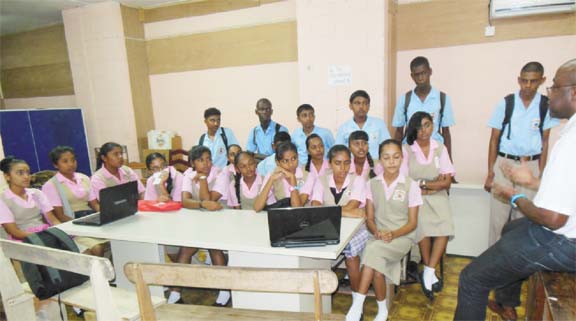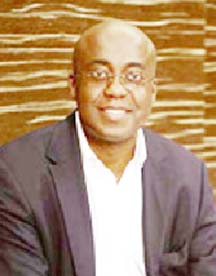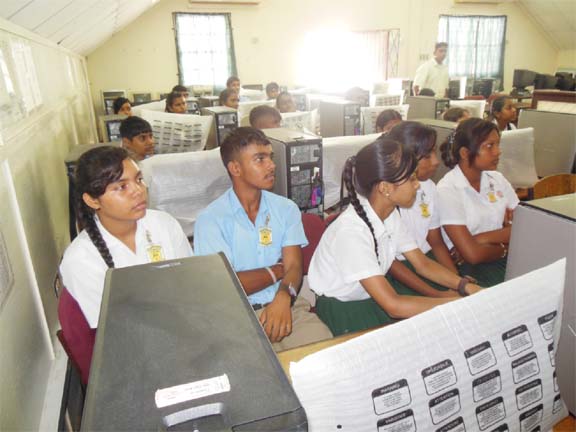Since Kojo Parris was the beneficiary of a sound education, he wanted to create an avenue to help students achieve this as well, and so together with likeminded persons he has created the Roraima Learning Trust (RLT). This is based on the micro-learning philosophy, a platform adopted from the Knowledge Pulse (KP), offered by the University of Salzburg.
Given the ever evolving technological world, the programme is designed to target students through the many electronic devices that are available.
Parris, who is Guyana’s Honorary Consul to South Africa, has already started a pilot programme in eight schools after the initiative was embraced by the Ministry of Education and other partners.
During a recent sit-down with the Sunday Stabroek Parris explained that what they are attempting is to take the bank of examination questions from first to sixth forms and put them into a format for children to access electronically.

“The idea is very, very simple; it is to increase the rate at which kids can absorb facts. We are not claiming to deal with issues around synthesis and analysis of information which are important parts of the education system. We are simply saying that this approach will increase the rate at which kids can absorb facts. Once you have absorbed facts then you can start analyzing and synthesising,” Parris told the Sunday Stabroek.
He explained that with the micro-learning approach complexities are broken down into small bytes and if repeated often enough like the times-table then they will be absorbed eventually.
Parris, a self-styled social entrepreneur with a broad range of experience, said he had approached the Ministry of Education pointing out that there is teacher shortage, and one way of dealing with this was to reduce the amount of time spent testing students in class. The rationale behind this is that if more of the testing is moved outside of class time then more hours could be spent in class dealing with the synthesis and the analysis.
But more importantly, according to Parris, children are more comfortable on electronic devices such as laptops and as such they should be spoken to via these media and given alternatives to the many games and Facebook.
These arguments apparently satisfied the ministry which indicated that if Parris and his team reached it half way then there would be a deal. He provided most of the cash resources while the ministry has pitched in with teachers and other resources to ensure that the questions are well designed. The ministry also provides stipends and travelling allowances.
Explaining the process Parris said a typical question is transformed into a “learning card and that learning card is uploaded onto a platform and then kids have free access to it.”

“The ambition is [during] the next school year across ten subjects from first to sixth forms kids can access this throughout the country,” he said.
The ten subjects will be selected by the ministry, but a month ago a pilot of the programme was launched covering Mathematics and Chemistry for fourth form students only across eight schools. Those schools are the Tagore High School, New Amsterdam Multilateral, President’s College, Saints Stanislaus College, Tutorial High School, McKenzie High, Anna Regina Multilateral and West Demerara Secondary School. No interior school was included in the pilot, but Parris said when the full roll-out is done schools from around the country will be included. The national roll-out is expected to be done by the beginning of the new school year.
Once successful Parris said there are plans to have the programme introduced at the primary and university levels.
Feedback
Questioned on what method would be used to assess the impact of the programme, Parris said the manner in which it is geared the programme itself has some inbuilt capabilities to get feedback. According to him each child would have a record of how they performed and they can ask how they are performing relative to other students, but they would not see the scores of the other students but rather see them aggregated. The teachers can also follow how students are performing and they can develop specific lesson plans.
At the level of the heads of school and the ministry, they can gauge from the programme what subject areas are problematic and they can then plan their budgets much more accurately and scientifically, because they have the details.

They would also have a record of how many students are actually using the programme because from the time they sign on the data will be collected, and in fact once the student signs on to the programme they will be hooked, albeit involuntarily. Parris explaine
d that once the student signs on even if they close the programme it will keep popping up back once they are using the device.
“In theory it can’t be closed…” he said.
The programme can also be used from cellular phones and when it was pointed out that the popping up feature may become annoying to some students, Parris said it will if they don’t keep updating the programme which they plan to do. He added though that there will always be a minority of students who would simply not want to be a part of the programme.
While the programme can be used independently of the school Parris said their first priority is to collaborate with the education ministry and he said the ministry, particularly Minister Priya Manickchand and her staff, has been amazing in terms of providing support for the programme.
Asked about accessibility, as there may not be internet connectivity for all students and some may not even have access to electronic devices, Parris disclosed that they have partnered with the One Laptop programme. And they have readily embraced the initiative as it will be the first platform that will be loaded on the computers that is relevant to Guyana.
“So reach is not a problem and it is free access…” Parris said, adding that they also have an arrangement with E-Networks to ensure it will be a gradual process.
E-Networks has been installing hot spots in all the schools, and according to Parris said that they were also welcoming of the idea and are providing the hot spots free of cost.
“I am pretty confident that with the various cables and the nature of the platforms that we are using anyway not too many students in Guyana will not have a cell phone with internet connection,” he said
.
And students can visit a hot spot, download the progamme and work with it off line before returning to upload their answers.
‘Fabulous education’
And while the idea is his, Parris pointed out that no idea can have one owner.
“I got a fabulous education, I have been very lucky in life…” Parris said when asked what was the driving force behind the initiative. He said that his father, former education minister Malcolm Parris, told him that education was the only thing he could give him.
“I think it is our obligation to try and ensure that we give to the next generation as many tools as possible to exceed our own achievements,” Parris said.
And Parris is not shy to admit that there is a “little bit of ego involved” as it is about a legacy, since he wants to ensure that they create a world-beating system that will enable students to self-educate.
“I would hope that it would endure, become bigger and better…” he said; that it would also be used in the Caribbean and the wider world as a Guyanese product.
And it is not something he has been thinking about for years, as Parris said it had its genesis as recently as one year ago, even though he was part of an approach some time back called Teach-Zimbabwe, where lots of money was raised and historically black schools were rehabilitated.
It was a chance meeting with an Australian national at an airport who told him about a programme he was part of using the called micro-learning platform, that caused him to see the confluence of what he was doing and what they could do. While the Australian programme is designed for adult education and while their programme is meant to run on cell phones it was reformatted to be used on laptops and other electronic devices in the Guyana context.
On board with Parris are University of Guyana lecturers Patrick Ketwaru and Denise Simons and the ministry has allocated many of their subject specialists who are creating the content. However, there is need for more subject specialists.
Parris said his team members are all working pro-bono, as he is tapping into that Guyanese spirit of self-interested philanthropy. Apart from him being a trustee of the programme his father and former Speaker Ralph Ramkarran are also trustees
.
Parris is a Buxtonian who won the Guyana scholarship and studied engineering at Cambridge University, after which he worked for Booker Tate for several years. However, he later found out that he was a “terrible engineer” and he did not enjoy estate life. He returned to London where he studied accounting and worked in management consultancy before joining a small investment bank which sent him to Zimbabwe where he spent “the seven best years of my life.”
In 2002 he was transferred to South Africa to open a branch of another bank he had joined in the interim, and he was lucky that the next year he retired.
“I spent a year not really knowing what I wanted to do with my life and then I became very interested in the idea about how we could use the same tool not to create lots of money but to create instead lots of social values, to address issues of housing, education, etc, for the poor, and that is where I got involved in what is called social entrepreneurship.”
Over the years he has spent some time lecturing and giving talks as he is “apparently an authority on social entrepreneurship.”





